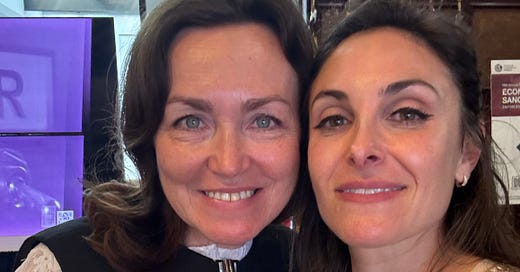Today marks exactly one year since I told my first story on Substack. I had no idea then that HUMINT would exceed 10,000+ subscribers. Or that I would get to spend part of this day with Alsu Kurmasheva, a journalist who had been unjustly imprisoned in Russia and who was the subject of my first report.
On May 1, 2024, I was just sitting on my deck, hoping I could keep telling intelligence stories, after becoming yet another laid off journalist.
Life feels different today. And I had wanted to write some smart and eloquent reflection, but time got away from me. So instead, let me bring you on the journey of what the day was like:
I listened to an edit of the next SpyCast episode dropping Tuesday. I suggested we bring back some of the levity of the interview — I search hard for levity.
I got coffee with a former senior official whose chilling words will send me into an important new story in the days ahead.
Then I started getting texts about how Mike Waltz was out as national security adviser. It had been less than two months since he accidentally included a journalist in a Signal chat where top officials were planning a military strike. Who would take the reigns? And would President Donald Trump’s second term resemble the first, with four national security advisers in four years?
Trump soon announced on his social media platform that in the interim, the gig would go to Marco Rubio — already the Secretary of State, acting Administrator for the United States Agency for International Development, and acting Archivist for the National Archives and Records Administration. Sort of like Henry Kissinger, who simultaneously led the State Department and served as national security adviser, but on steroids. Some people also began to question whether Defense Secretary Pete Hegseth could be next, in the wake of his own exposed Signal chats.
A friend came over and sat on my deck for a little while. We laughed looking at an Instagram post that says, “We really living in the most difficult section of someone’s AP gov exam in 2053.”
In the evening, I drove to the National Press Club, which is hosting events in the lead up to World Press Freedom Day on May 3. I found a parking spot between two protests — one against a high end hotel and another against the president.
Inside the press club, the first person I saw was Alsu. We had planned to meet here and hugged in front of a clock that is still ticking for Austin Tice — the journalist and veteran who was abducted while reporting in Syria in 2012 and whose whereabouts remain a mystery.
In came Pavel, Alsu’s husband. We walked down the hall as concerns hung heavy over the future funding of Radio Free Europe/Radio Liberty, the publication that has employed Alsu and Pavel for years. A federal judge recently ordered the Trump administration to disburse RFE’s Congressionally approved funds… but just for the month of April. Then on Wednesday night, an appeals court ruled that the money could continue to be withheld — a temporary block that could end in the lower court being overruled.
The three of us sat down in the back row of a small room. A panel of journalists from a small independent Arctic news outlet, the Barents Observer, were describing their work covering the Russia-Norway border region.
One of them was a young Russian journalist who joined remotely. She described being arrested in Russia for posting commentary about the war on social media. The Kremlin didn’t like that. She ended up fleeing to Norway, but still found a spy from Russia’s domestic security service circling her house there.
Our work matters, Barents Observer editor Thomas Nilson told the room. That is why Russia has tried so hard to silence journalists.
An out-of-work journalist from Voice of America asked a question. And I got a text from a person who informed me of yet another reduction of a national security team that has yet to be reported.
It was still warm out in D.C. when I drove home, windows open, feeling the layers of life collide.




Congrats! One of many to come